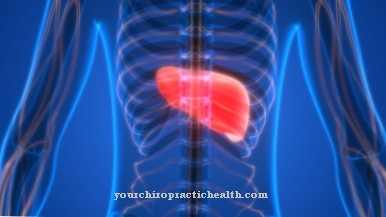Of the enterohepatic circulation describes the transport route of some substances, such as nutrients, drugs or poisons, in the body. These substances circulate from the liver via the gallbladder to the intestines and back to the liver. Some substances can go through this cycle several times.
What is the enterohepatic cycle?

The enterohepatic circulation is also called Liver-intestinal circulation designated. It describes the circulation of substances in the body, which takes place from the liver via the gallbladder to the intestine and back to the liver. The substance in question can traverse this path up to twelve times in a day. Substances that are no longer needed or could not be absorbed after passing through the enterohepatic cycle are excreted in the stool.
The enterohepatic cycle is not the body's own mechanism, but results from the chemical and physical properties of the substances. The behavior of the substances in the body is determined from these properties.
Not all substances that enter the body are subject to liver-intestinal circulation. Substances taken orally are primarily subject to her.
Function & task
The enterohepatic cycle begins in the liver. This is where the respective substances (for example cholesterol) are formed. After their production, the substances are stored in the next station in the cycle, the gallbladder. It is then released from the gall bladder into the duodenum. After the substances have fulfilled their intended purpose from there, they are returned from the small intestine to the liver. The return occurs through the so-called portal vein, which is the connection between the small intestine and the liver.
The enterohepatic circulation is of great importance for a whole range of substances that the body absolutely needs for the maintenance of its functions. These include bile acid and vitamin B12. The liver-intestinal circulation enables the human body to absorb and use the supplied substances such as nutrients or medicinal substances more effectively. The enterohepatic cycle reduces the amount that the body has to absorb or produce itself.
By chemically changing a substance, it is possible to influence its chemical properties in such a way that it is subject to the enterohepatic cycle to a different extent. The extent to which the respective substances depend on the enterohepatic circulation depends not only on their chemical and physical properties but also on their concentration in the blood and in the intestine.
The liver-intestinal circulation has a particularly important function for bile acid. Around 90 percent of the bile acids are subject to the enterohepatic cycle. About four grams of the acid circulate between the liver and intestines several times a day. This significantly reduces the need for newly synthesized bile acid from the liver. Normally, the level of all substances relevant for bile acid regulates itself. If the bile acids are prevented from being absorbed, their synthesis in the liver is increased.Since cholesterol is a necessary substance for this, the cholesterol level in the blood decreases. This principle has been applied to the way cholesterol-lowering drugs work.
In the case of pharmaceuticals, the enterohepatic cycle is only relevant for substances that are absorbed via the intestine. This applies in particular to preparations taken orally. Conversely, the enterohepatic cycle can be bypassed with drugs that are not absorbed via the gastrointestinal tract. These include intravenous and intermuscular injections and sublingual medications and nasal sprays.
It is also possible, for example after the accidental ingestion of toxins, to withdraw substances from the enterohepatic circulation by administering activated charcoal and thus to prevent their full effect. The activated charcoal binds the substances in the intestine and excretes them unprocessed.
Illnesses & ailments
The enterohepatic cycle is not the body's own mechanism, but results from the properties of the substances supplied. Thus, it does not fulfill any specific function for the body, but it can change the way substances such as drugs work in a positive or negative way.
The enterohepatic cycle also plays an important role in the vitamin B12 balance. The vitamin B12 is stored in the liver. Since the body can reabsorb it, it only needs a very small amount per day. The body's own supplies usually last up to ten years, even with a vitamin B12-free diet such as veganism. However, if the circulation of vitamin B12 is disturbed, the supply can be used up much faster. This can lead to a vitamin B12 deficiency, which has far-reaching effects on the body.
The enterohepatic cycle can change the strength and timing of the effect of a substance. The substances produced by the liver can be broken down in the intestine, making them more soluble. As a result, their absorbability increases. If a substance circulates very frequently due to its chemical and physical properties, the effect of the substance can occur later, while its half-life and thus the time it remains in the body is extended. If this is not taken into account when a drug is administered multiple times, an overdose can occur. An overdose can cause symptoms of poisoning and liver damage.
The same principle applies to some poisons. Due to the circulation between the liver and the intestine, their effect is delayed and therefore more surprising, but at the same time stronger and longer-term. As a result, dangerous poisonings are often not registered at all at first.
























.jpg)



